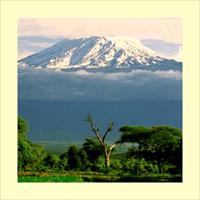Africa bears the brunt of climate change, WWF

The sparkling glaciers high up in the Rwenzori Mountains—and their crystal-clean mountain streams—may be no more, according to WWF, the global conservation organization. Climate change has taken its toll on some of Africa’s highest peaks; the mountains’ glaciers are on their knees.
A 27-person team from eight nationalities has just returned from the Rwenzori Mountains with some startling observations. “I have never seen the glaciers shrink to this level in my 25 years of climbing the Rwenzori Mountains,” exclaimed one porter accompanying the team.
WWF, together with the Congolese Institute for Nature Conservation (ICCN) and the Uganda Wildlife Authority (UWA) had organised an ambitious 10-day expedition from DRC to Uganda that criss-crossed the massif and reached the Margharita peak at 5,119m above sea level.
The team was able to take pictures of the glaciers exactly as they were taken in 1952 and 1956. The data gathered show that the mountains’ glaciers have shrunk by more than 50 per cent in the last 50 years. From 650ha in 1906, the glaciers shrunk to 352ha in 1955 and 148ha in 2008. At this rate, WWF estimates that the glaciers will completely disappear in the next 30 years.
The highest peaks of these mountains are permanently snow-capped, and they, along with Mount Kilimanjaro and Mount Kenya are the only such ones in Africa. The Rwenzori Mountains are shared by Uganda and the Democratic Republic of Congo (DRC) and are the third highest mountains on the continent.
“The impact of melting of glaciers was felt by the team when it discovered that the route leading from DRC to Uganda used a glacier that no longer exists, forcing the team to open a new route” says Marc Languy, head of WWF’s Programme in the Great Lakes region. “However, the impact is more severe on wildlife and the vegetation that can not adapt to the new condition fast enough. While it was comforting to find many signs of leopards, chimpanzees and other wildlife, one wonders how they will survive if changes continue at the present rate”.
During this expedition, WWF, the Congolese Institute for Nature Conservation and the Uganda Wildlife Authority embarked on important conservation work in the Virunga and the Rwenzori Mountains National Parks in eastern Democratic Republic of Congo and western Uganda. WWF is very keen to have the Ugandan part of Ruwenzori designated as a Ramsar site as the mountains glaciers and the high altitude lakes, bogs and rivers are a critical source of freshwater.
“The rivers and wetlands that I saw in this amazing ecosystem were just phenomenal. But the simple fact remains–they are threatened,” says Dr. Musonda Mumba, WWF’s Freshwater Programme Coordinator for eastern Africa. “Their ability to provide water for both nature and man is really jeopardised by the changes that are taking place. Speaking to local people it is already clear that the rainfall pattern has changed and this is having an effect on water resources,” adds Dr. Mumba.
WWF has helped to rehabilitate the trails and mountain huts so as to reopen tourism on the DRC side while opening new routes to link the two countries.
 Back and Next - Back and Next
Back and Next - Back and Next See Also - See Also
See Also - See Also